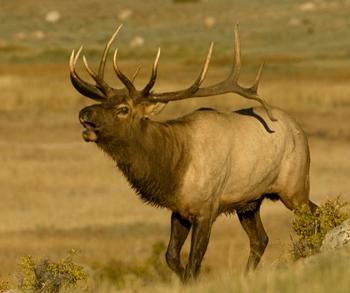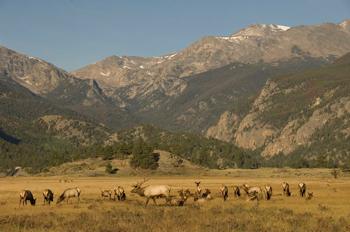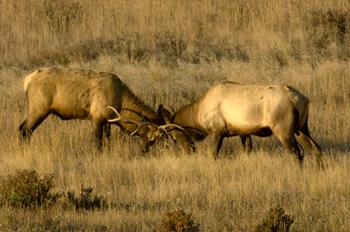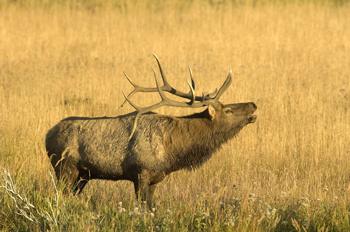5 Secrets To A Successful Elk Hunt
By Doug Rellstab
Whenever I get a newbie to elk hunting camp I always tell them the same things. First I tell them that an elk is the most amazing and beautiful animal I have ever hunted. Majestic is the word that comes to mind, so respect what they represent and the landscape they inhabit. It is a rare gift to be able to hunt this animal in the most fantastic of settings in the lower 48.

Elk are a herd animal and are always led by an older "lead" cow. Contrary to the myth that the big old bull is lord and master of the woods, it is the lead cow that rules. She picks the routes, grazing, and bedding areas. Even during the rut when you think the bull is in charge it is the cow that really sets the stage. She picks the where and the when and the bull just blindly follows, bugling his rhapsody of love, challenge and frustration. Sound familiar, guys?

Elk are habitual creatures, following the same routes regularly on a daily and seasonal basis. Of course they are migratory and won't show up at the exact same water hole or meadow every day at the same time. They will use all the waterholes, parks and bedding areas in their territory, migrating from one to the next and back again. How long will they cycle through their territory depends on the quality of browse and how big an area they have picked out for themselves. It could be a square mile or many square miles and they might travel just a 1/2 mile or up to several miles in a single day. It is up to you to dial in to their territory and routine. Under pressure that territory will expand to a much larger area and they may select less than prime browse if the area feels more secure. This usually leads you to thicker cover, steeper terrain or more remote locations.
But one thing is for sure, they have to eat. And they will invariably follow a trail, any trail, and they know them all. So therein lies the guessing game. Which one do you choose to watch over? It stands to reason that undisturbed they will follow the best trails to the choicest browse. Under pressure, which begins about one hour after opening day, they go for the more remote trails near the thicker cover and away from danger. And if danger is everywhere often they will find the thickest nastiest patches of short pines or deadfall to hunker down in. Like those smart old bucks, I have seen them hold so tight; they will flush like a pheasant when you are literally 10's of feet from them. You'll be lucky to have one second for a hindquarter shot.
This is an example of what I'm talking about. During one season my elk hunting buddy and I split up to rouse up some elk. I came upon a very small circular meadow about 30' wide that was bordered by some small pines, aspens and one huge old pine at the edge. I stood in the middle of that meadow for 15 minutes listening to the woods and not moving. Then out of the corner of my eye I caught the shiny glint of an eye. I turned and focused on the rest of the outline, it was a 3x3 bull that was standing under the lower boughs of the massive pine. He had been under that pine the entire time I was standing there just 25' from me. I had swung my rifle at my hip to an off hand hip shot position. I hesitated momentarily contemplating an off hand shot. That long second of hesitation was all the small bull needed to bolt and vanish like a ghost into the forest.

During the fall rifle season and after the rut is over it will still be warm by elk standards. A group of elk as small as a few to as many as 20 animals will usually bed up high for the night, typically on a cooler north facing hillside about two-thirds of the way up, where visibility and wind conditions favor detection of predators. They like cover that is not very thick, with good views in all directions. Aspen groves or at the base of large pines are favorite bedding places. Also, being high up gives them the option of jumping over the ridge or taking a side hill or downhill direction for a quick get away. But if you are in bottom land country where there is a lot of open ground between creek bottoms and hillsides, you may find them in tall grass and thick willows if that is the only cover available. They seem to get up and graze about every 3-4 hours or so, from early dawn till 8, then again around noon, and again at sundown, grazing until midnight if the moon is right.
Their sense of smell is incredible, probably their most developed sense, so pay attention to the wind. Never ever walk with the wind to your back. Do so and you just bought yourself a nice day of walking through the woods with nothing to show for it but the exercise. Of course if you have been elected to push out any elk, then by all means do so. Just put your smelliest guy in elk camp upwind of any possible elk holds.
Those big fuzzy radar ears of theirs work pretty well too. If the weather is dry I always put on a quality pair of moccasins, nothing beats them for quiet except stocking feet, which I've done my share of when on a close quarters elk sneak. And don't be afraid to do the ole hands and knees crawl, or even better a belly crawl. Now for us old guys, like me, you might enjoy a leisurely nap with one eye open either in short cover or leaning against a tree. With the right wind you have a 50/50 chance of an elk coming in from upwind. Or even more amazing is when you believe you have a great clear view of the terrain and all of a sudden there is an elk at 50 yards that has seemingly risen right up out of the ground. Whoa, where did he come from! I was looking that way too! Remember the old Bosco commercial: "You can chase all over but you can't beat Bosco". Well it is the same for elk. If you find someone who can outrun an elk, be sure to invite him to elk camp. Any serious elk hunter should also get himself a walker game ear; it will triple your hearing distance. I recently misplaced mine during my last hunt and feel at a great disadvantage without it.

Now an elk's eyesight leaves something to be desired; it is not that good. They will see movement well enough, but stand perfectly still and they will hold for you while you check each other out. Cows usually will bolt sooner, but bulls are a bit more curious, especially young ones. I have often had standoffs lasting many minutes. Here is another story of one of my most memorable elk moments that illustrates the value of stillness. It was a gorgeous breezy day in the woods, great for moving around undetected. I happened upon a midday bedding of some 20 elk. I was scent free and camouflaged head to toe. I had my Mathews bow in one hand and my cow call to my lips under my head net in the other. I eased ever so slowly for nearly an hour to edge of the herd where the closest I could get to the only bull was 45 yards. As I stood there completely still and in awe of the scene before me, 10 yards away a small calf rose and eyed me curiously. She eased over step by step until I was looking down at her just a few feet away. Not moving a single muscle for what seemed like an eternity I decided to twitch my call hand an inch. Her eyes bulged and she bolted a step back then the rest of the herd stood up! I drew my knocked arrow for a behind the shoulder shot at the bull, thankfully it struck home. It was a beautiful day and fantastic hunt. I learned that when everything comes together you'll have memories that will last forever.
Let's see, is that 5 secrets? Habits, wind, quiet, stillness and oh yeah, I forgot the last one, enjoyment. Revel in the moment, take in the scenery and bring back tall tales to the campfire because those memories will burn clear in your mind for a lifetime.
Klee
A Wyoming elk addict
Doug Rellstab is 56 years old and lives in Pinedale Wyoming. He is geologist by trade. "I moved here 22 years ago from Colorado and never looked back." He spends his free time fishing, hunting and just tramping through the woods with his 4 kids. "Some people like to jump out of planes or ride the rapids for fun but on the night of the full moon, in the heat of the rut, my elk hunting buddy and I like to call up bulls. We rouse them into such a frenzy at such close quarters its a wonder we haven't been skewered. We call it playing with the elk." Recently a group of friends formed a rag tag group of long range shooter wantabees.
By Doug Rellstab
Whenever I get a newbie to elk hunting camp I always tell them the same things. First I tell them that an elk is the most amazing and beautiful animal I have ever hunted. Majestic is the word that comes to mind, so respect what they represent and the landscape they inhabit. It is a rare gift to be able to hunt this animal in the most fantastic of settings in the lower 48.

Elk are a herd animal and are always led by an older "lead" cow. Contrary to the myth that the big old bull is lord and master of the woods, it is the lead cow that rules. She picks the routes, grazing, and bedding areas. Even during the rut when you think the bull is in charge it is the cow that really sets the stage. She picks the where and the when and the bull just blindly follows, bugling his rhapsody of love, challenge and frustration. Sound familiar, guys?

Elk are habitual creatures, following the same routes regularly on a daily and seasonal basis. Of course they are migratory and won't show up at the exact same water hole or meadow every day at the same time. They will use all the waterholes, parks and bedding areas in their territory, migrating from one to the next and back again. How long will they cycle through their territory depends on the quality of browse and how big an area they have picked out for themselves. It could be a square mile or many square miles and they might travel just a 1/2 mile or up to several miles in a single day. It is up to you to dial in to their territory and routine. Under pressure that territory will expand to a much larger area and they may select less than prime browse if the area feels more secure. This usually leads you to thicker cover, steeper terrain or more remote locations.
But one thing is for sure, they have to eat. And they will invariably follow a trail, any trail, and they know them all. So therein lies the guessing game. Which one do you choose to watch over? It stands to reason that undisturbed they will follow the best trails to the choicest browse. Under pressure, which begins about one hour after opening day, they go for the more remote trails near the thicker cover and away from danger. And if danger is everywhere often they will find the thickest nastiest patches of short pines or deadfall to hunker down in. Like those smart old bucks, I have seen them hold so tight; they will flush like a pheasant when you are literally 10's of feet from them. You'll be lucky to have one second for a hindquarter shot.
This is an example of what I'm talking about. During one season my elk hunting buddy and I split up to rouse up some elk. I came upon a very small circular meadow about 30' wide that was bordered by some small pines, aspens and one huge old pine at the edge. I stood in the middle of that meadow for 15 minutes listening to the woods and not moving. Then out of the corner of my eye I caught the shiny glint of an eye. I turned and focused on the rest of the outline, it was a 3x3 bull that was standing under the lower boughs of the massive pine. He had been under that pine the entire time I was standing there just 25' from me. I had swung my rifle at my hip to an off hand hip shot position. I hesitated momentarily contemplating an off hand shot. That long second of hesitation was all the small bull needed to bolt and vanish like a ghost into the forest.

During the fall rifle season and after the rut is over it will still be warm by elk standards. A group of elk as small as a few to as many as 20 animals will usually bed up high for the night, typically on a cooler north facing hillside about two-thirds of the way up, where visibility and wind conditions favor detection of predators. They like cover that is not very thick, with good views in all directions. Aspen groves or at the base of large pines are favorite bedding places. Also, being high up gives them the option of jumping over the ridge or taking a side hill or downhill direction for a quick get away. But if you are in bottom land country where there is a lot of open ground between creek bottoms and hillsides, you may find them in tall grass and thick willows if that is the only cover available. They seem to get up and graze about every 3-4 hours or so, from early dawn till 8, then again around noon, and again at sundown, grazing until midnight if the moon is right.
Their sense of smell is incredible, probably their most developed sense, so pay attention to the wind. Never ever walk with the wind to your back. Do so and you just bought yourself a nice day of walking through the woods with nothing to show for it but the exercise. Of course if you have been elected to push out any elk, then by all means do so. Just put your smelliest guy in elk camp upwind of any possible elk holds.
Those big fuzzy radar ears of theirs work pretty well too. If the weather is dry I always put on a quality pair of moccasins, nothing beats them for quiet except stocking feet, which I've done my share of when on a close quarters elk sneak. And don't be afraid to do the ole hands and knees crawl, or even better a belly crawl. Now for us old guys, like me, you might enjoy a leisurely nap with one eye open either in short cover or leaning against a tree. With the right wind you have a 50/50 chance of an elk coming in from upwind. Or even more amazing is when you believe you have a great clear view of the terrain and all of a sudden there is an elk at 50 yards that has seemingly risen right up out of the ground. Whoa, where did he come from! I was looking that way too! Remember the old Bosco commercial: "You can chase all over but you can't beat Bosco". Well it is the same for elk. If you find someone who can outrun an elk, be sure to invite him to elk camp. Any serious elk hunter should also get himself a walker game ear; it will triple your hearing distance. I recently misplaced mine during my last hunt and feel at a great disadvantage without it.

Now an elk's eyesight leaves something to be desired; it is not that good. They will see movement well enough, but stand perfectly still and they will hold for you while you check each other out. Cows usually will bolt sooner, but bulls are a bit more curious, especially young ones. I have often had standoffs lasting many minutes. Here is another story of one of my most memorable elk moments that illustrates the value of stillness. It was a gorgeous breezy day in the woods, great for moving around undetected. I happened upon a midday bedding of some 20 elk. I was scent free and camouflaged head to toe. I had my Mathews bow in one hand and my cow call to my lips under my head net in the other. I eased ever so slowly for nearly an hour to edge of the herd where the closest I could get to the only bull was 45 yards. As I stood there completely still and in awe of the scene before me, 10 yards away a small calf rose and eyed me curiously. She eased over step by step until I was looking down at her just a few feet away. Not moving a single muscle for what seemed like an eternity I decided to twitch my call hand an inch. Her eyes bulged and she bolted a step back then the rest of the herd stood up! I drew my knocked arrow for a behind the shoulder shot at the bull, thankfully it struck home. It was a beautiful day and fantastic hunt. I learned that when everything comes together you'll have memories that will last forever.
Let's see, is that 5 secrets? Habits, wind, quiet, stillness and oh yeah, I forgot the last one, enjoyment. Revel in the moment, take in the scenery and bring back tall tales to the campfire because those memories will burn clear in your mind for a lifetime.
Klee
A Wyoming elk addict
Doug Rellstab is 56 years old and lives in Pinedale Wyoming. He is geologist by trade. "I moved here 22 years ago from Colorado and never looked back." He spends his free time fishing, hunting and just tramping through the woods with his 4 kids. "Some people like to jump out of planes or ride the rapids for fun but on the night of the full moon, in the heat of the rut, my elk hunting buddy and I like to call up bulls. We rouse them into such a frenzy at such close quarters its a wonder we haven't been skewered. We call it playing with the elk." Recently a group of friends formed a rag tag group of long range shooter wantabees.

